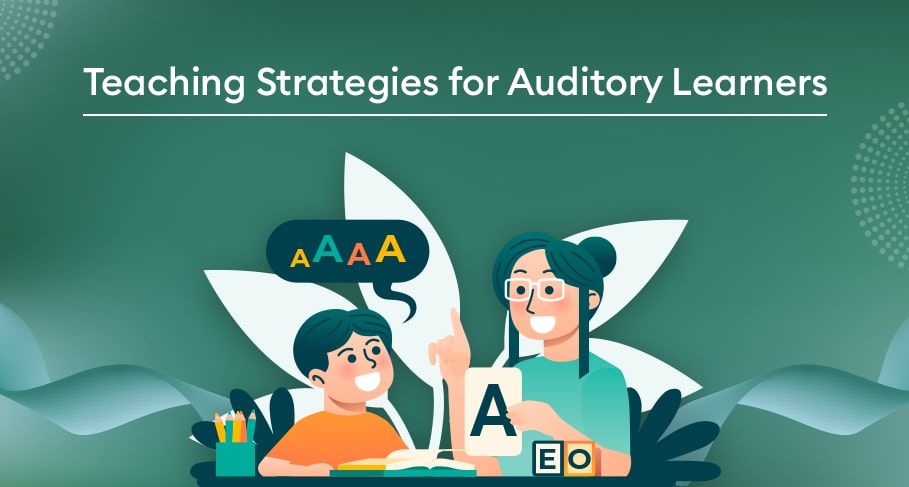Students have different learning preferences. While some enjoy conventional text-based learning, many students prefer audio and videos. With eLearning in play, it has become possible to provide students with learning content based on their learning style. However, classroom learning still involves the chalk-and-talk method, and it can be challenging to fit all students’ needs.
Auditory learners learn effectively through sound. They prefer read-aloud sessions over silent book reading and lectures instead of read-through assignments. An audio element can make their learning journey effective and enjoyable.
To thoroughly understand what auditory learning is, make sure you read this post, What is Auditory Learning (Audio Based Learning)?
Here are a few strategies to help educators make way for auditory learners in daily classroom activities.
Play Background music
Auditory learners work best when there’s background sound as opposed to silence. Music can help auditory learners concentrate better and learn efficiently. Educators can allow students to use headphones in the classroom. If the entire class is comfortable, try playing soothing music as background audio when they learn or do deep focus work.
Begin Lessons with Lectures or Discussions
Since spoken instruction works best for auditory learners, a lecture or group discussion would be the best way to start a lesson. Both mediums include verbal information and expression, making them ideal for auditory learners. Additionally, these will encourage students to think and comprehend their learning. Another critical point is to record the lectures. While many students prefer making notes, auditory learners benefit more from recorded lectures. Ensure that recorded lectures are shared with all the students and that they have open accessibility.
Since verbal instruction and repetition are ideal for auditory #learners, record lectures and have them available anytime so #students can always revisit them.
Learn about adapting to different learning styles here: https://t.co/Xw1ARennAj#auditorylearning #learningstyles pic.twitter.com/fnXqkfj1rN
— Noodle Factory (@noodlefactorysg) October 27, 2021
Use Text-to-Speech or Audio Books When Available
When you can’t start lessons with a discussion, consider using a text-to-speech tool for auditory learners. Listening to text is better than reading it when the students learn better from oral input. Auditory learners benefit from hearing more than reading assignments. Even when they have to read aloud the assignments or comprehend the topic, it will help them more in processing information than just plain reading. Audiobooks are also excellent add-ons that educators must try.
Use Closing Discussions
A casual conversation around the lesson and understanding the topic can help bring auditory elements to the classrooms. It also makes room for a better understanding of students’ learning needs. Also, it opens the stage for students to comprehend their learning. For instance, an auditory learner can explain the concepts discussed, and other students can engage. Through this activity, students can engage in a healthy debate, and educators would better understand students’ knowledge and gaps.
Asking students to summarise what they’ve learned is a unique listening experience because they will hear themselves speak and understand other students learning. This exercise lets them identify what they are missing and how to catch up.
Use Videos
Adding educational videos can enhance the learning experience for all students regardless of their learning styles. Videos are a great way to stimulate your learning content, and auditory learners get the sound element and visuals to help them learn effectively. Supplemental videos are a great way to practice flipped learning, teach concepts that are procedure based, like science experiments or bring interactivity to learning content like adding videos on classic English literature plays.
Read Assignment Instructions Aloud
This strategy can help auditory learners understand expectations for assignments clearly. It will work amazingly well for students with little or no preference for read/write learning. You can also ask students to share their choice of preferences for assignments. For instance, a student may want to write the project, while others may want to do a podcast or presentation on the given topic. This helps students express their knowledge and understanding in ways that suit them the best.
Integrate Podcasts and Audiobooks
Podcasts and audiobooks have gained popularity in recent years. They are great resources for auditory learners. Finding podcasts and audiobooks that cover the subject as required for students might be challenging. However, they work wonderfully to learn new things and for general information. For instance, podcasts on STEM education or English grammar may help students in various ways but not necessarily cover the concepts as per their grades. Include sharing age and grade-appropriate resources with students, and auditory learners will enjoy their learning experience.
Also Read: Popular Podcasts Education Leaders Must Check Out
While providing tailored instruction for auditory learners in a classroom with kids with varied learning styles may be challenging, integrating a few of the above strategies can help educators provide an audio element in the learning experience, making it effective for auditory learners.
